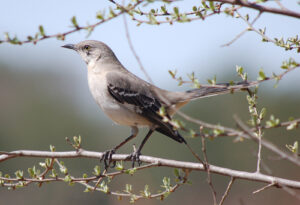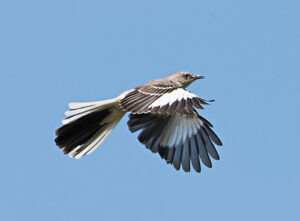Master Mimic: the Northern Mockingbird
“There is probably no bird in the world that possesses all the musical qualifications of this king of song, who has derived all from Nature’s self.” — John James Audubon,
Birds of America.
Mockingbirds can produce a wide variety of sounds and up to 350 unique songs! They are known for mimicking other birds, the sound of machinery, and even human music. It’s not surprising their Latin name is Mimus polyglottos which translates to many-tongued mimic, while a polyglot is a person who speaks many languages. At a recent outdoor event in a park I thrilled to a mockingbird demonstrating its repertoire, singing for long stretches of time without repeating any one phrase.
These talented singers are linked to popular American culture from the “Mockingjay” from the Hunger Games to the world-famous novel To Kill A Mockingbird. One online study explains, “The title of To Kill a Mockingbird has very little literal connection to the plot, but it carries a great deal of symbolic weight in the book. In this story of innocence destroyed by evil, the ‘mockingbird’ comes to represent the idea of innocence. Thus, to kill a mockingbird is to destroy innocence.”
The longest quotation about the book’s title appears in Chapter 10, when Scout explains:
“‘Remember it’s a sin to kill a mockingbird.’ That was the only time I ever heard Atticus say it was a sin to do something, and I asked Miss Maudie about it.
‘Your father’s right,’ she said. ‘Mockingbirds don’t do one thing but make music for us to enjoy…but sing their hearts out for us. That’s why it’s a sin to kill a mockingbird.”
The song “Listen to the Mockingbird” is woven deep into American culture. Written in 1855, it was one of the most popular songs of the nineteenth century selling millions of copies of sheet music and was sung (and whistled) throughout the United States and parts of Europe. This popularity carried over into the 20th century with the song featured as the instrumental introduction to a number of the early short films by The Three Stooges, rendered comically with birds chirping cheerily in the background. Not coincidentally, once and future Stooge Shemp Howard whistles it repeatedly throughout the classic 1940’s film comedy, The Bank Dick, starring the immortal W.C. Fields. It was also used as the theme song for Terrytoon’s magpie characters, the mischievous Heckle and Jeckle.
Although there are 16 bird species worldwide with the name “mockingbird” there is only one native to the United States where it is a year-round resident. Northern Mockingbirds have easily adapted to human development and reside across suburban towns and cities where open lawns and parks make perfect hunting grounds for their insect prey. Males often sing solo from high perches like the tops of houses and telephone poles, where their performance often involves leaping into the air and fluttering back down.
There are several purposes for the white patches on a Northern Mockingbird’s wings and outer tail feathers: These plumes of white are displayed during mating rituals, and it also flashes them in defense of their territory from potential predators like hawks and snakes.
Mockingbirds are extraordinarily territorial. They will often swoop and dive at pretty much anything they consider a threat, including people, if they get to close to theirs nests, which are usually between 3 and 10 feet off the ground in bushes or thickets. They will also chase other birds, such as crows, away from their food sources like fruit-bearing trees in winter.
The next time you see or hear a mockingbird, take a little time to enjoy its variety of song and see if you can whistle along.
Ross A. Feldner, RCC Board Member
 Ross Feldner is the lead, with Bob Musil, of the RCC Bird Watch and Wonder Program. Ross is a life-long birder and photographer who is the editor of the Friends of Patuxent National Wildlife Refuge newsletter. Ross also serves as a guide at the Patuxent National Wildlife Refuge, a frequent birding spot for Rachel Carson who first learned about the health effects of DDT at the laboratory there. He is also the owner/art director of New Age Graphics, a full-service graphic design firm in Wheaton, MD.
Ross Feldner is the lead, with Bob Musil, of the RCC Bird Watch and Wonder Program. Ross is a life-long birder and photographer who is the editor of the Friends of Patuxent National Wildlife Refuge newsletter. Ross also serves as a guide at the Patuxent National Wildlife Refuge, a frequent birding spot for Rachel Carson who first learned about the health effects of DDT at the laboratory there. He is also the owner/art director of New Age Graphics, a full-service graphic design firm in Wheaton, MD.










